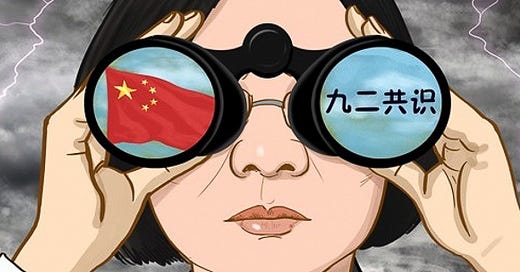The '1992 Consensus' is an understanding purportedly reached between delegates of the People's Republic of China (PRC) and the Republic of China (ROC, Taiwan) at talks in Hong Kong in 1992. The primary offering from Beijing of 'one China' had been made previously; what it meant has remained contentious
The term ‘consensus’ only emerged after the DPP’s 2000 election win, when Su Qi 苏起, Minister of the Executive Yuan’s Mainland Affairs Council, coined it to encapsulate the 1992 talks as broadly inclusive—even enabling DPP engagement with Beijing.
often used interchangeably with the 'One-China Principle' (一中原则), ‘consensus’ was intended to mean ‘One China, respective interpretations' (一个中国, 各自表述). Yet Beijing rejected this in 1995
the 1992 meeting had closed without agreeing even on the scope of ‘China’; hence its ‘Consensus' is dubbed a 'consensus of no consensus'
Beijing endorsed the term in 2005 after talks between the CPC and Kuomintang (KMT, Nationalist Party), the Taiwanese descendant of the pre-1949 ruling party. However, the PRC only refers to the 'One China' part of this term and bridges it to the 'One-China Principle,' which claims one sovereign state called 'China,' the PRC being its sole legitimate government, with Taiwan considered an inalienable province
the KMT insists on 'respective interpretations,' implying that 'China' refers to the ROC, legitimate since its constitutional establishment in 1912. It appears Beijing tacitly allows Taipei to interpret it in this way.
The existence and terms of this 'consensus' constitute an insoluble dilemma like several others in geopolitics. The DPP rejects its validity and legitimacy, viewing it as undermining Taiwan's sovereignty because it means Taiwan is part of ‘China’, either of the PRC or ROC. Under the CPC, denying this sovereignty is among the most fundamental political doctrines. Hence, there are, in fact, two mutually contradictory consensuses.
While the initial ambiguity of the 'consensus' made dialogue between Beijing and Taipei easier, especially during the KMT-led governments from 2008 to 2016, it has become increasingly unworkable. For example, in 2019, Tsai Ing-wen 蔡英文 equated it with ‘One Country, Two Systems’. Its interpretation and acceptance are now significant points of contention in cross-strait relations, particularly as Taiwan's domestic politics and regional geopolitics have shifted.



